What Is Data Wharehouse? [Complete Guide]
Table of Contents
In this article, we will start by sharing a data warehouse definition with examples and then explain the benefits of owning a data warehouse for businesses. So let’s move ahead.
What is a Data Warehouse?
A data warehouse is a digital data warehouse used to store detailed information about a company. It is used to create and organize reports through records that the company provides. Then use these reports to make important decisions based on the facts presented.
A data warehouse collects information from a company so that it can have better control over a particular process, providing greater flexibility in the searches and information they need.
In addition to maintaining an information history, Data Warehouse creates standards by optimizing analyzed data for all systems, correcting errors and restructuring data without affecting the operating system, and providing only a final structured model for analysis.
How To Build a Data Warehouse?
To build a data warehouse, you must go through the following 7 steps in order:
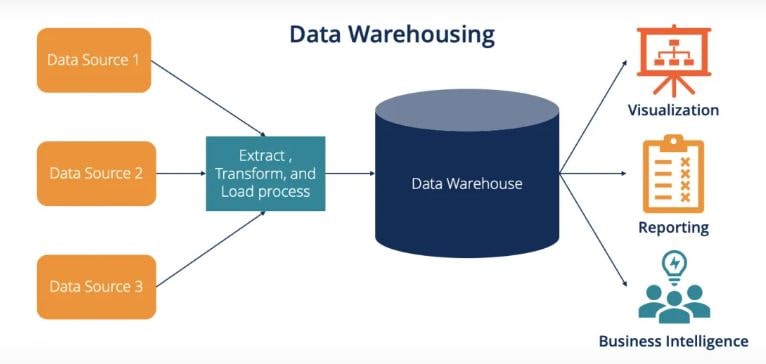
Determining Business Goals
- Determining business goals (tactical and strategic)
- Identifying and prioritizing the expectations and needs of the company, departments, and business users from the project
- Examining the company’s current technological architecture, and applications in use.
- Conduct a preliminary analysis
- Description of the scope of the data warehouse
This step takes 3 to 20 days.
Conceptualization And Platform Selection
- Define the set of characteristics of the desired data warehouse solution
- Choosing the optimal deployment option (on-site/cloud/hybrid)
- Choosing an optimal architectural design approach for building a data warehouse
- Choosing data warehouse technologies considering the number of data sources and the volume of data to load into the data warehouse
- Data streams for implementation
This stage takes between 3 and 15 days.
Create a Project Roadmap
- Defining the scope of the data warehouse development project, budget planning, schedule, etc.
- Planning design, development, and testing
- Compilation of data warehouse project scope documents, data warehouse solution architecture vision document, data warehouse deployment strategy, test strategy, project implementation roadmap
- Developing a risk management plan
- Estimating data warehouse development project efforts, TCO and ROI
The approximate time of this stage is 4 to 15 days.
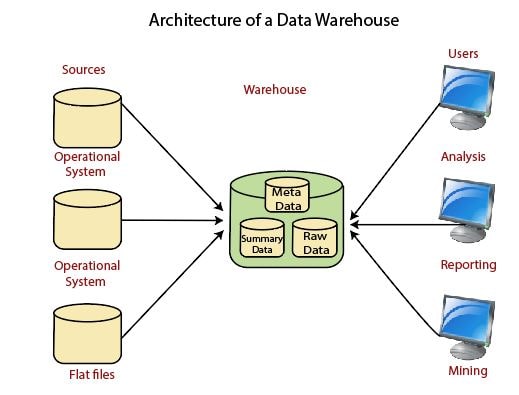
System Analysis And Data Warehouse Architecture Design
- Detailed analysis of each data source
- Data types and structures
- The volume of data generated daily
- The degree of sensitivity of data and the approach of access to applied data
- Data quality, missing/undervalued data, possibility to perform data cleansing in the data source system
- Communication with other data sources
- Designing data cleaning policies
- Creating data security policies (data access policies based on legal restrictions and data security rules, data encryption policies, data access monitoring and data compliance policies, data backup strategy, etc.)
- Designing data models for data warehouse and data mart
- Design ETL/ELT processes to integrate and control data flow
It takes at least 15 days to complete this step.
Development And Stabilization
- Data warehouse platform customization
- Configuring data security software and implementing data security policies
- ETL/ELT development and testing
- Data warehouse performance testing
Setting Up
- Data transfer, data quality assessment
- Introducing the data warehouse to business users
- Holding meetings and training workshops for users
Support After Launch
- ETL / ELT performance configuration
- Configure data warehouse performance and availability
- Support for end users
- Many users and technical experts may ask what is the difference between a data warehouse and a data center.
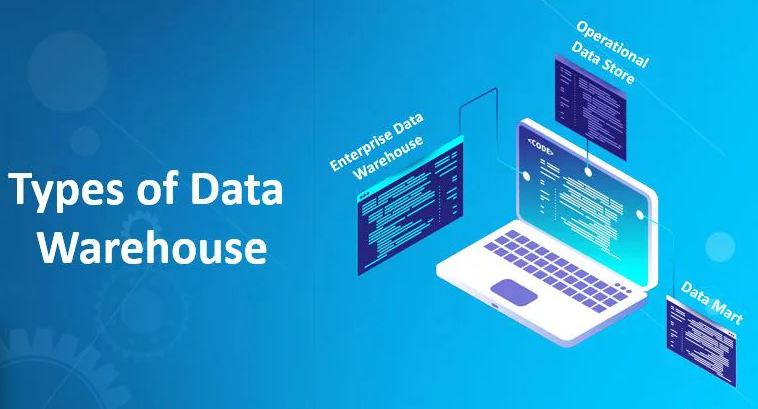
Types of Data Warehouse
There are three main types of Data Warehouses (DWH) that are mainly used in enterprise systems. They are:
Enterprise Data Warehouse (EDW): As a central data warehouse, EDW provides a holistic approach to organizing and presenting data.
Operational Data Store (ODS): ODS is a suitable data store when neither OLTP nor DWH can support business reporting requirements.
Data Mart: Data Market is designed for departmental data, such as sales, finance, and supply chain.
Differences Between Data Warehouses And Databases
The main differences that distinguish data warehouses (DM) from databases (DB) can be summarized as follows:
- Data warehouses are updated periodically (weekly, monthly, or another period), while databases are constantly updated all the time.
- Data in data warehouses are used for viewing only, while data in databases are checked and corrected.
- Database outputs are used to support decisions, while data warehouse outputs are used to see the impact of decisions and analyze the response after they are made.
Difference Between Data Warehouses And Data Centers
- Data centers are physical locations where servers are kept.
- While data warehouse is a software concept and actually a data structure on one or more servers.
Components Of Data Warehouse
A typical data warehouse often includes the following elements:
- A relational database for storing and managing data
- An Extract, Load, and Transform (ELT) solution to prepare data for analysis
- Statistical analysis, reporting, and data mining capabilities
- Customer analytics tools to visualize and present data to business users
Reasons For Using a Data Warehouse
Data warehouses offer the overall advantage of allowing organizations to analyze large volumes of disparate data and extract valuable and meaningful information from them. The following four unique features allow data warehouses to provide organizations with this overall advantage:
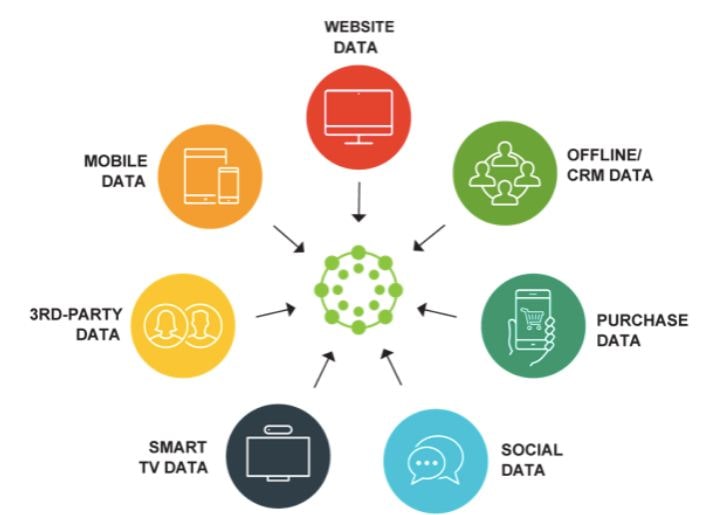
Subject-Oriented: Data warehouses can analyze data related to a specific subject or functional area (such as sales).
Integrated: Data warehouses create consistency between data types from different sources.
Immutable: Once data is stored in a data warehouse, it remains stable and does not change.
Variable Time Window: Analysis in the data warehouse can be done in different time windows.
A well-designed data warehouse responds quickly to queries, has high throughput, and provides enough flexibility for end users to analyze large volumes of data easily and at high speed.
Data Warehouse Examples
The data warehouse has many real-world applications in the corporate world to facilitate business decisions. Let’s look at some examples of how they are used in various industries to better understand the definition of a data warehouse.
In Retail
For the retail sector, a good example is the retail data market which includes customer information from cash registers, mailing lists, websites, and comment cards. Similarly, another suitable example of the application is the healthcare sector which uses it to access patient reports, share important data with insurance providers, forecast outcomes, etc.
In Health Care
In healthcare, these central data stores are used to record patient information from the various units of the medical unit. This may include personal patient information, financial transactions with the hospital, and insurance data. All this is integrated into the data warehouse and linked through the database schema.
In Construction
Similarly, in construction, builders require data on every purchase made during the construction schedule. This purchase should be credited to a source for making financial decisions. The same goes for the wages of contract employees.
All this data will be recorded in the data warehouse and later used in business intelligence by key decision makers to estimate the company’s total spending on a single construction site.
In Finance
Banks, insurance companies, commercial companies, and other companies related to the financial sector need accurate data at all times. This is only possible when the data in the databases is validated correctly and appropriately connected to other tables in the database.
These are just examples of how data warehouses are widely used in different industries and for different purposes. Since it is just an organized store of raw data, it can serve many purposes for the end use
Data Warehouse Tools
There are many data storage tools available in the market. Here are some examples of the most famous data warehouse tools:
MarkLogic
This tool is a useful data warehousing solution that makes data integration easier and faster by using some organizational features. This tool makes very complex search processes easier. MarkLogic can convert many types of data, such as documents, relationships, and metadata, into queries.
Oracle
Oracle is a leading database in the data industry. The tool offers a wide range of data warehouse solutions and helps optimize customer experiences by increasing operational efficiency.
Amazon RedShift
Amazon Redshift is one of the best data warehouse tools; A simple and cost-effective tool for analyzing all types of data using standard SQL and existing BI tools. This tool allows us to run complex queries against petabytes of structured data using query optimization techniques.
Advantages of Data Warehouse
The data warehouse maintains a copy of the information from the source transaction systems. This architectural complexity provides the opportunity to:
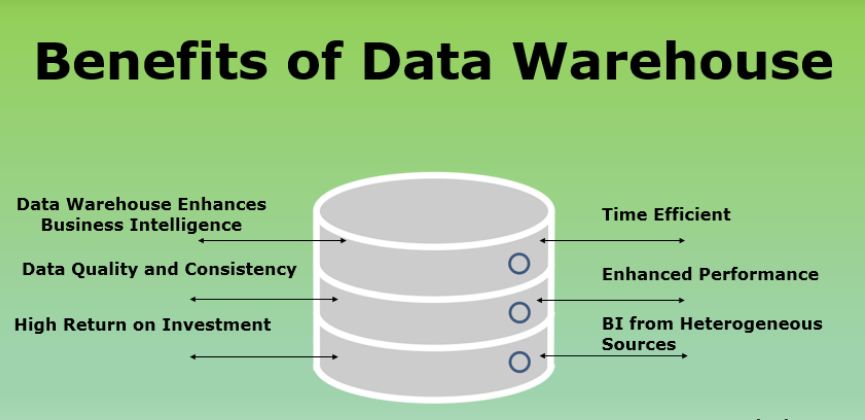
- Consolidate data from multiple sources into a single database and data model. More data collection in a single database so that a single query engine can be used to display the data in ODS.
- Mitigating the contention of database isolation level locking in transaction processing systems caused by attempts to run large and long-running analyze queries in transaction processing databases.
- Keep a history of the data, even if the source transaction systems don’t.
- Integrate data from multiple source systems, enabling centralized visibility across the enterprise. This feature is always valuable, but especially when the organization has grown by consolidation.
- Improve data quality, by providing consistent codes and descriptions, reporting or even fixing bad data.
- Provide organization information regularly.
- Provide one common data model for all data of interest, regardless of the data source.
- Restructure the data so that it makes sense for business users.
- Restructure data so that it delivers excellent query performance, even for complex analytical queries, without affecting operating systems.
- Adding value to operational business applications, particularly Customer Relationship Management (CRM) systems.
- Make decision support queries easier to write.
- Organize and demystify repetitive data.
Drawbacks of Data Warehouse
- The data warehouse also has some drawbacks, including:
- They are not a suitable solution for unstructured data;
- They can have high costs and can get old quickly.
FAQS
Q1:- What are data warehouse applications?
Ans:- Information from Operation Data Sources are integrated by storing data into a central repository to initiate the analysis and mining of integrated information and use it primarily for strategic decision-making via Online Analytical Processing (OLAP) techniques.
Q2:- Why is a data warehouse important?
Ans:- A data warehouse is a special type of database. It is used to store large amounts of data, such as analytics, historical, or customer data, and then generate large reports and mine data against it. Different functions require different databases or databases to be mapped with their disks for different uses.
Q3:- What is in the data warehouse?
Ans:- A data warehouse is a relational database designed for query and analysis rather than transaction processing. History usually contains data derived from transaction data, but it can include data from other sources.
Q4:- What is the difference between a data market and a data store?
Ans:- The data mart is a subset of the data warehouse and is usually oriented to a particular line of business or team. While data warehouses have depth at the enterprise level, the information in the data market belongs to a single department.
Q5:- What is a database and data warehouse?
Ans:- It is used for reporting purposes while the database is for the current day to process online transactions. The most important difference between them is that in Database and Data is normally maintained normally while in Data Warehouse format, normalization is intentionally de-normalized to avoid joins while generating huge reports to save time.
Q6:- What is SQL Server Data Warehouse?
Ans:- The data warehouse aggregates data scattered into various data sources across the enterprise and helps business stakeholders manage their operations by making better-informed decisions. Most organizations have multiple data stores: relational databases, spreadsheets, mainframes, mail systems, or even paper files.
Q7:- What is the difference between OLAP and OLTP?
Ans:- In the OLTP database there is detailed and current data, and the schema used to store transactional databases is the entity model (usually 3NF). OLAP ( Online Analytical Processing) has a relatively low transaction volume. Queries are often very complex and involve aggregations.
Q9:- What is a fact table?
Ans:- In data warehousing, a fact table consists of measurements, metrics, or facts of a business process. It is located in the center of a star or snowflake diagram surrounded by the dimensions of the tables. The primary key of a fact table is usually a compound key consisting of all its foreign keys.
Q10:- What is ERP in a data warehouse?
Ans:- Enterprise resource planning and data warehousing. The purpose of data warehouses is to extract data from disparate sources, clean it, and align it so that it can be aggregated, compared, and analyzed to enable business decisions. Then, it is stored in a single shared platform optimized to support enterprise-wide data analytics.
Q11:- What is the use of OLAP in a data warehouse?
Ans:- OLAP cube is a multidimensional database optimized for online data warehouse and analytical processing ( OLAP ) applications. An OLAP cube is a method of storing data in a multidimensional form, generally for reporting purposes. In OLAP cubes, data (metrics) are categorized by dimensions.
Q12:- What is meant by data storage and data mining?
Ans:- Collections of databases that work together are called data repositories. This makes it possible to integrate data from multiple databases. Data mining is used to help individuals and organizations make better decisions.
Q13:- What is data warehouse testing?
Ans:- ETL stands for Extract-Transform-Load and is a process for how data is loaded from the source system into a data warehouse file. The data is extracted from an OLTP database, converted to match the data warehouse schema, and loaded into the database data warehouse file.
Q14:- What is a data lake?
Ans:- A data lake is a storage repository that holds a huge amount of raw data in its original format until it is needed. Whereas a hierarchical data warehouse stores data in files or folders, a data lake uses a flat structure for data storage.
Q15:- What is a star chart?
Ans:- In computing, a star schema is the simplest data market schema and is the most widely used approach for developing dimensional data warehouses and data aggregators. The star chart consists of one or more fact tables that refer to any number of dimension tables.
Q16:- What is the meaning of OLAP?
Ans:- Online Analytical Processing
Q17:- What is the difference between a data warehouse and a data mining application?
Ans:- In other words, data storage is the process of collecting and organizing data into a single shared database, and data mining is the process of meaningfully extracting data from that database. Data mining is a data-driven process collected in the data housing stage in order to reveal meaningful patterns.
Q18:- What does OLTP mean?
Ans:- Online transaction processing
Q19:- What is the definition of data mining?
Ans:- Data mining is a process that companies use to turn data raw materials into useful information. By using software to find patterns in large batches of data, businesses can learn more about their customers and develop more effective marketing strategies as well as increase sales and reduce costs.
Q20:- What is meant by data modeling?
Ans:- Data modeling is often the first step in database design and object-oriented programming where designers first create a visualization of how the data and elements relate to each other. Data modeling involves the evolution from a conceptual model to a logical model to a physical schema.
Conclusion
Data is essential for organizations to make informed decisions, so it makes sense that data warehouses are important to any organization because they store all the data. Without a data warehouse, you cannot access the flow of information and benefit from business intelligence in your business.
Data warehouses help you store large amounts of data in a central database, keep it in a secure location, and analyze the data for your business needs when needed.
In simpler terms, a data center is a physical room or building where data servers and computers are located. While a data warehouse is just a type of software database that is used for reporting and analyzing data and is one of the main components of business intelligence.
Another thing that may be confused with a data warehouse is a database. We will continue to explain the difference between a data warehouse and a database.

